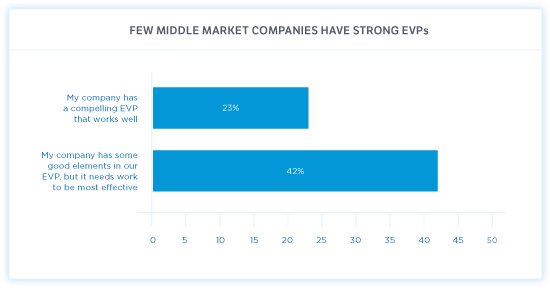
A firm’s employee value proposition or EVP is the total combination of benefits and rewards that employees receive in return for working for the company. EVP includes tangibles like salary and benefits, as well as intangibles such as meaningfulness of work and company culture. This post asks five important questions middle market firms should be able to answer about their employee value proposition.
Research by the National Center for the Middle Market reveals that a strong EVP is critical in the quest for candidates to fill top management and professional positions. The research shows that a little less than a quarter—23%—of middle market executives believe their companies have compelling EVPs that work well. An additional 42% of executives say their companies have some good elements in their EVPs, but their value propositions need work to make them more effective.

Regardless of where your firm falls along this spectrum, it’s a good idea to evaluate your EVP and see if it’s up to date and working as hard as it could be. The following checklist can help you determine if your company is taking advantage of all EVP best practices. And it might give you the edge you need to seal the deal with a top talent candidate you’ve been courting.
- Does your EVP set your firm apart? The best candidates are likely to have many opportunities. So what makes yours the most interesting? Keep in mind that money isn’t everything, and salary is also easy to match. But if your company is growing rapidly, if it has a truly unique culture, or if it offers creative perks, that can give you a real advantage.
Remember that you’re not just competing with other middle market companies in your same industry or town. Mid-sized firms have to compete with major corporations operating in more glamorous locations and industries. That makes it all the more important to have a distinctive EVP that resonates with candidates.
- Does your EVP appeal to passive candidates? According to research by the Center’s partner, The Novo Group, 60% of the candidate pool is passive, or not actively looking for a new opportunity. That’s a big pool of people you can’t afford to overlook.
If you want these candidates to consider your position, your EVP should incorporate elements that are most likely to attract their attention. Novo’s research says that passive candidates are most interested in competitive salary, growth opportunities, work/life balance, and opportunities for promotion.
- Is your EVP legit? In other words, is the EVP that senior management promotes consistent with what your employees think and say about your firm? It’s critical for an EVP to be an authentic, genuine reflection of the value your company provides. If your C-suite thinks your company’s culture, people, and mission are part of what attracts talent, but your employees don’t agree, you may need to rethink what makes your firm appealing.
- Does your EVP reflect your employer brand? Mapping your EVP back to your employer brand—or your firm’s reputation as a place to work—lends authenticity to the image you are promoting to employees and candidates. For example, if you say your company cares about the health and wellness of its employees, then offering employees access to an onsite gym, exercise classes, or subsidized fitness club memberships are natural fits for your EVP. On the other hand, if you promote your company as a hip place to work, but you have rigid pay scales, hours, and dress codes, that can be a major disconnect and turnoff for potential candidates.
Omelet, an L.A.-based advertising agency and a recent Middle Market Company of the Month, is a great example of a firm with an EVP that lives up to its employer brand. The company touts itself as a creative and rewarding place to work; and the benefits it offers don’t disappoint. A backyard bar, time set aside each week for employees to focus on passion projects, and unlimited personal time off are just a few of the advantages that help the firm deliver on its employer brand. They use their company Instagram account to convey some of the quirkiness of their employees and showcase employee life at the office.


- Are you effectively promoting your EVP? No matter how attractive your EVP, if nobody knows about it, then it’s not doing its job. For starters, your hiring managers must be able to articulate your EVP. But since these people can’t possibly connect with all potential candidates, you need to use of other channels to get the word out. Middle market companies that are best at packaging and delivering their EVPs use a wide range of tools, including digital media, social sites, partnering with business schools, and networking in their communities and industries.
Interested in learning more about creating and promoting a strong EVP? See How to Create Bullet-Proof Talent Tools And Put Them to Work for Your Business. Or access the Center’s top talent research, Building the Top Team: How Middle Market Firms Attract and Retain the Top Talent that Fuels Their Success.
Six things your middle market company can do to establish a great employer brand and EVP. View Infographic >
Take a deeper look at how your company can build a team of top talent with these 11 steps. View Infographic >